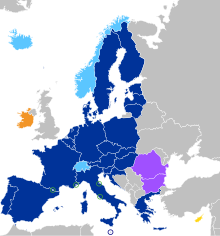Entry / exit system
The entry / exit system EES (for English Exit-Entry-System ) is a large-scale IT system planned by the European Union for the automatic monitoring of travel by third-country nationals at the external borders of the Schengen area . The project is part of the EU Commission's Smart Borders agenda and is intended to be an accompanying measure for the free movement of persons in the area of freedom, security and justice .
Legal basis / history of origin
The basis is the EU regulation 2017/2226. A draft prepared by the EU Commission has passed the legislative process. The European Parliament approved the Commission's draft with amendments on October 25, 2017 in first reading. On November 20, 2017, the Council of the European Union adopted the draft and the amendments. The regulation was published in the Official Journal of the European Union on December 9, 2017 . In accordance with Article 73 of the regulation, this came into force on December 30, 2017.
Range of functions
The system is intended to collect data on crossing the border at the EU's external border and replace the stamping of passports. The collected data should be the master data such as B. Name and date of birth. In addition, biometric data such as fingerprints and photos should be saved.
Acquisition process
When entering the Schengen area for the first time, a dossier is created for each person. The master data and the biometric data are stored in this. Every time the external border is crossed, information on the travel movement is added to this data record. This includes information on the day and time as well as information on the control point.
Use of the data
The data is used to automatically calculate the length of a person's stay in the Schengen area. Should someone exceed the permitted period of stay due to a visa being issued or entry without a visa (90 days in 180 days), the member states are automatically informed of this.
Access permissions
In principle, only public bodies in the Member States should be able to access the system. These are:
- Border authorities, in Germany the Federal Police
- Immigration authorities, in Germany for example the immigration authorities
- Visa authorities, in Germany the embassies and the immigration authorities
- Law enforcement and security authorities (to prevent and prosecute serious crimes)
As an exception to these regulations, the following international organizations should have access:
- UN organizations such as the UNHCR
- the International Committee of the Red Cross
- the International Organization for Migration
privacy
The data collected should be deleted five years after the last departure was recorded.
business
The system is to be operated by the EU agency eu-LISA . According to information from eu-LISA, it was planned that operations should start in 2020. The Swiss customs administration, however, writes that operations should start in the third quarter of 2021.
